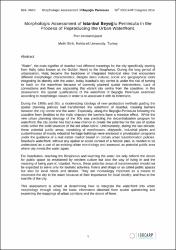Morphologic Assessment of Istanbul Beyoglu Peninsula In the Process of Reproducing the Urban Waterfront

Göster/
Erişim
info:eu-repo/semantics/openAccesshttp://creativecommons.org/publicdomain/zero/1.0/Tarih
2014-11Üst veri
Tüm öğe kaydını gösterKünye
Birik, Melih (2014). "Morphologic Assessment of Istanbul Beyoglu Peninsula In the Process of Reproducing the Urban Waterfront". Proceedings of the 50th ISOCARP Congress, Urban Transformations – Cities and Water, Gdynia - Poland. ISOCARP, The HagueÖzet
“Water”, the main signifier of Istanbul had different meanings for the city specifically starting from Haliç (also known as the Golden Horn) to the Bosphorus. During the long period of urbanization, Haliç became the backbone of integrated historical sites that encounters different morphologic characteristics. Despite deep cultural, social and geographical roots integrating its identity with the water, today Istanbul’s city centre is under the risk of turning its back on the waterfront because of currently planned spatial interventions. Lack of connections and flows are separating this vibrant city centre from the coastline. In this assessment, the spatial qualifications of the waterfront of Beyoğlu Peninsula examined according to morphologic values in order to re-associate it with its hinterland. During the 1950s and 60s, a modernizing ideology of new production methods guiding the spatial planning policies had transformed the waterfront of Istanbul, creating barriers between the city centre and the water. Especially, along the Beyoğlu Peninsula following the coastline from Besiktas to the Halic shipyard the barriers have a massive effect. While the new urban planning ideology of the 80s was predicting the decentralization program for waterfront, the city centre has had a new chance to create the potential for the use of spatial voids within the solid structure of the old urban fabric. Unfortunately, during the last decade, these potential public areas, consisting of warehouses, shipyards, industrial plants and customhouses of mostly industrial heritage buildings were enclosed in privatization programs under the guidance of a real estate market based on certain urban transformation policies. İstanbul’s waterfront; without any spatial or social context of a holistic plan, is needed to be understood as a part of an existing urban morphology and assessed as potential public area where city meets the water again. For Istanbulies, reaching the Bosphorus and touching the water not only reflects the desire for public space as envisioned by western culture but also the way of living in and the meaning of being part of, Istanbul. Hence, these potential areas of transformation should not be expected to serve only for touristic activities, hotels and shops or so called public spaces but also for local needs and desires. They are increasingly important as a means to reconnect the city to the water because of their importance for local identity, and thus to the true life of the city. This assessment is aimed at determining how to integrate the waterfront into urban morphology through using the basic information obtained from spatial questioning and examining the mappings of urban corridors and the desire of flows.
Kaynak
ISOCARP - International Society of City and Regional PlannersKoleksiyonlar
Aşağıdaki lisans dosyası bu öğe ile ilişkilidir:
İlgili Öğeler
Başlık, yazar, küratör ve konuya göre gösterilen ilgili öğeler.
-
Kent Estetik Kurulları Kavramı Ve Kırklareli’nin Kentsel Kalitesinin Artırılmasına olası Etkileri
Eyüboğlu Erşen, Aysun (Kocaeli Üniversitesi, 2014-05-08)ÖZ Mimarlığın doğasında var olan “estetik değerler”, aynı zamanda birçok binadan oluşan kentlerin birbirinden ayırt edilmesini sağlayan değerlerdir. Zaten yaratılan fiziksel çevreler kendiliğinden bir estetik değer de ... -
Adil Kent Yaklaşımı ve Kentsel Dönüşüm: İstanbul Esenler Örneği
Çolak, Yunus (2014-06)Günümüz kentlerinin gelişme alanlarının doğurduğu sorunlar ve kentsel dönüşüm önemli bir tartışmakonusudur. Kentsel geliştirmede ve dönüşümlerde öncelikler, kamu araçları ile yapılan müdahalelerinmekânda ürettiği hareketliliğin ... -
XIII-XV. Yüzyıllarda Anadolu Kentleri Ve Kentliler
Boz, Murat (2014-11-27)Tarih alanında kentler ile ilgili birçok çalışmanın varlığı bilinmektedir. Ancak bu çalışmada onlardan farklı olarak kent denilen olgunun tek bir yönüne değinmek ya da belli bir kenti ele almak yerine belli bir dönem üzerine ...



















